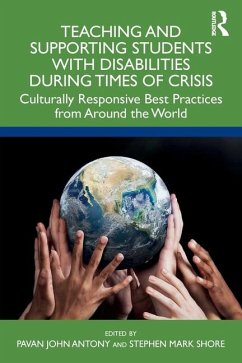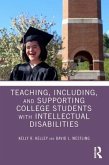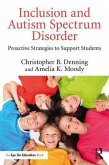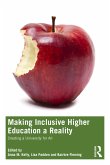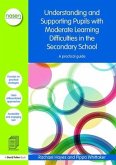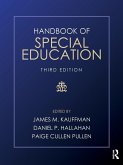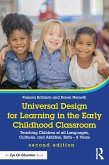Teaching and Supporting Students with Disabilities During Times of Crisis
Culturally Responsive Best Practices from Around the World
Herausgegeben:Antony, Pavan; Shore, Stephen
Teaching and Supporting Students with Disabilities During Times of Crisis
Culturally Responsive Best Practices from Around the World
Herausgegeben:Antony, Pavan; Shore, Stephen
- Broschiertes Buch
- Merkliste
- Auf die Merkliste
- Bewerten Bewerten
- Teilen
- Produkt teilen
- Produkterinnerung
- Produkterinnerung
This volume offers international perspectives on the disproportionate impact COVID-19 has had on disabled students and their families, serving as a call to action for educational systems and education policy to become proactive, rather than reactive, for future disasters. Each chapter in the book is written by authors with lived experiences across diverse global regions, highlighting the daily life of people with disabilities and their families during the pandemic. Including case studies and practical suggestions, the book demonstrates that culturally responsive practices are essential to…mehr
Andere Kunden interessierten sich auch für
![Teaching, Including, and Supporting College Students with Intellectual Disabilities Teaching, Including, and Supporting College Students with Intellectual Disabilities]() Kelly KelleyTeaching, Including, and Supporting College Students with Intellectual Disabilities32,99 €
Kelly KelleyTeaching, Including, and Supporting College Students with Intellectual Disabilities32,99 €![Inclusion and Autism Spectrum Disorder Inclusion and Autism Spectrum Disorder]() Christopher B. DenningInclusion and Autism Spectrum Disorder31,99 €
Christopher B. DenningInclusion and Autism Spectrum Disorder31,99 €![Making Inclusive Higher Education a Reality Making Inclusive Higher Education a Reality]() Making Inclusive Higher Education a Reality34,99 €
Making Inclusive Higher Education a Reality34,99 €![Pandemic Pedagogies Pandemic Pedagogies]() Pandemic Pedagogies38,99 €
Pandemic Pedagogies38,99 €![Understanding and Supporting Pupils with Moderate Learning Difficulties in the Secondary School Understanding and Supporting Pupils with Moderate Learning Difficulties in the Secondary School]() Rachael HayesUnderstanding and Supporting Pupils with Moderate Learning Difficulties in the Secondary School44,99 €
Rachael HayesUnderstanding and Supporting Pupils with Moderate Learning Difficulties in the Secondary School44,99 €![Handbook of Special Education Handbook of Special Education]() Handbook of Special Education106,99 €
Handbook of Special Education106,99 €![Universal Design for Learning in the Early Childhood Classroom Universal Design for Learning in the Early Childhood Classroom]() Pamela BrillanteUniversal Design for Learning in the Early Childhood Classroom31,99 €
Pamela BrillanteUniversal Design for Learning in the Early Childhood Classroom31,99 €-
-
-
This volume offers international perspectives on the disproportionate impact COVID-19 has had on disabled students and their families, serving as a call to action for educational systems and education policy to become proactive, rather than reactive, for future disasters. Each chapter in the book is written by authors with lived experiences across diverse global regions, highlighting the daily life of people with disabilities and their families during the pandemic. Including case studies and practical suggestions, the book demonstrates that culturally responsive practices are essential to successfully support people around the world in their times of need. At the critical intersection of education and disability human rights, this book is important for pre-service teachers, researchers, professors, and graduate students to ensure all students are supported during times of crisis.
Produktdetails
- Produktdetails
- Verlag: Routledge / Taylor & Francis
- Seitenzahl: 296
- Erscheinungstermin: 9. April 2024
- Englisch
- Abmessung: 229mm x 152mm x 16mm
- Gewicht: 453g
- ISBN-13: 9781032606415
- ISBN-10: 103260641X
- Artikelnr.: 69936412
- Herstellerkennzeichnung
- Libri GmbH
- Europaallee 1
- 36244 Bad Hersfeld
- gpsr@libri.de
- Verlag: Routledge / Taylor & Francis
- Seitenzahl: 296
- Erscheinungstermin: 9. April 2024
- Englisch
- Abmessung: 229mm x 152mm x 16mm
- Gewicht: 453g
- ISBN-13: 9781032606415
- ISBN-10: 103260641X
- Artikelnr.: 69936412
- Herstellerkennzeichnung
- Libri GmbH
- Europaallee 1
- 36244 Bad Hersfeld
- gpsr@libri.de
Pavan John Antony is Full Professor of Special Education at Ruth S. Ammon College of Education and Health Sciences at Adelphi University, New York. Stephen Mark Shore is Associate Clinical Professor of Special Education at Ruth S. Ammon College of Education and Health Sciences at Adelphi University, New York, focusing on aligning best practices in supporting autistic people to lead fulfilling and productive lives.
Contributor Bios
Preface
Prologue
Section 1: Homeschooling during the pandemic
Chapter 1: Education during the Pandemic: United States
Access to Education During the Pandemic
Voices from the Field
Common Themes That Emerged from the above Cases
Support Strategies to Consider for People with Disabilities and Their Families
Conclusion
References
Section 2: Social Emotional Well Being
Chapter 2: Promoting the Mental Health and Wellbeing of Children with Disabilities: Algeria
Introduction
Disability and Education in Algeria
The Pandemic's Effects on Schools and Mental Health
Methodology
Study Findings
Mental Health Experiences of Children with Disabilities
Mental Health Experiences of Parents of Children with Disabilities
Supporting Children with Disabilities During the Pandemic
Redesigning Education to Promote Mental Health and Wellbeing
References
Section 3: Voices from Developing Countries
Chapter 3: Impact of Covid-19 on the Wellbeing of Children with Disabilities: Bangladesh
Authors Note
Introduction
Current Situation of Children with Disability: Legal and Social Protections
Challenges for Children with Disabilities During National Crisis in Bangladesh
Experiences of Children with Disabilities and Their Families in Bangladesh
Children with Locked-in Syndrome and Survival in Question During Covid-19
Children with Intellectual Disabilities and Covid-19
Children with Congenital Disabilities and Uncertainty about Self-help
Children with Autistic Syndrome and Deprived of Religious Practices
Children with Disabilities, Stigma, and Social Exclusion
Challenges to Support Children with Disabilities During Crisis
Responses to Support for Children with Disabilities
Discussions and Lessons Learned
Policy Strategies in Helping Children with Disabilities in Crisis
Conclusion
References
Chapter 4: A snapshot during the pandemic: Iraq
Introduction
Country and Geographical Location
Historical Background
Background of the Legal System
Challenges
Covid 19-crisis
Efforts to Overcome Crisis
Lessons Learned
Effective Strategies
Conclusion
References
Chapter 5: Parenting Children with Autism Spectrum Disorder: India
Introduction
Constitutional Provisions for Disability in India
Legal Provisions on Disability in India
Decoding Autism Spectrum Disorder (ASD)
Methodology
Autism Does Not Come with a Manual; It Comes with a Parent Who Never Gives Up
The Pandemic: A Boon or a Bane?
Findings & Discussion
Limitations and Conclusion
References
Section 4: NGOs Making a Difference
Chapter 6: Opportunity and Innovations by Centro Ann Sullivan: Peru
Introduction
Legal Systems and Education for Children with Disabilities in Peru
Other Relevant Crisis in the Country
Centro Ann Sullivan Del Peru - CASP: A Unique Model Program for Children with Different Abilities in Peru
Real-life Experiences During the Pandemic
The Pandemic Arrived in Peru
CASP's Virtual Model of Education
Results of Virtual Education for Families
One Parents Testimony
Results of Virtual Education for Students
Impact of the Pandemic on Student Workers Who Were Employed
Results of Virtual Education for the Staff
Lessons Learned
Conclusion
Chapter 7: A Natural Functional Approach to help People with Disabilities and Their Families: Brazil
The Ann Sullivan Center of Brazil - Ribeirão Preto (CASB-RP)
Before the Pandemic
The Pandemic
Remote Activities
New Challenges
Reflections and Future Directions
References
Section 5: Universal Design in Learning
Chapter 8: Teaching and Learning through UDL: Chile
Abstract
When Classes were Not in Classrooms
Traditional Teaching-centered Education Barriers
Teaching as a Means and Learning as a Goal
The Importance of Connectivity and Technological Resources in Flexible Learning
Background of the Course, Redesigning Education
How Affective Networks Were Addressed
Access to Learning: Providing Options to Recruit Interest.
Building of Learning: Providing Options to Sustain Effort and Persistence
Internalization of Learning: Providing Options for Self-regulation
How Recognition Networks Were Addressed
Access to Learning: Options for Perception
Building of Learning: Options for Language and Symbols
Internalization of Learning: Options for Comprehension
How Strategic Networks Were Addressed
Access to Learning: Options for Physical Action
Building of Learning: Options for Expression and Communication
Internalization of Learning: Options for Executive Function.
Conclusion
Acknowledgment
References
Section 6: Struggle for Inclusivity
Chapter 9: Individualistic and Collective shielding approaches: France
Introduction
Introducing the Country
France in the Covid Crisis: School closures and collective measure
Collective Measures
Individual Shielding Measures
Digital Green Certificate and Vaccination
People With Disabilities During the Covid Crisis
Collective Measures
Individual Shielding Measures
Students With a Visual Impairment and Presentation of the Population with a Visual Impairment
Collective Measures: Teleworking and Pedagogical Continuity
Individual Shielding Measures Consequences
Students With a Neurodevelopmental Disorder
Presentation of the Population with an ADHD
Collective Measures
Individual Measures
Conclusion
References
Chapter 10: Solving Problems to Support Children and Families: Japan
Abstract
Policies for Persons with Disabilities
Current Main Services
Relevant Crises and Support for People with Disabilities
Natural Disasters
Survey Reports
Challenges Faced by PWD and Efforts Made to Resolve Them
The Problem and Correspondences
Lessons Learned
Support for Persons (Children) With Disabilities During Covid-19
Conclusion
Acknowledgments
Chapter 11: Instructional Design and Delivery during the Pandemic: Taiwan
Introduction
Education of Children with Disabilities in Taiwan
The Epidemic Lessons Before Covid-19
Enterovirus Infection Outbreak in 1998 and Hand Hygiene Development
Sars Outbreak in 2003 and the Improvement in Epidemic Education in Schools
The Covid-19 Outbreak: Contingency Plan of Administration and Implementation in Taiwan
Before the Domestic Outbreak: January 2020 to Mid-May 2021
After the Domestic Outbreak: After Mid-May 2021
Issues in Distance Education
Challenges and Suggestions
Instructional Design
Instructional Delivery
Organizing the Curriculum
Conclusions
References
Chapter 12: Challenges, Best Practices and Solutions: Qatar
Introduction
Brief Introduction of the Background of Education for Persons with Disabilities (PWD) in Qatar
The Impact of the Covid-19 Pandemic and Lockdown in Qatar on PWD in Qatar
Barriers to Distance Learning for Students with Disabilities Post-pandemic
Lesson Learned
Conclusion
Resources
Chapter 13: Remedy in Desperation: Turkey
Introduction
Legal System and Offered Services for the Individuals with Disabilities in Turkey
Approaches to the Individuals During Disasters and the Pandemic in Turkey
Possible Strategies for a Better Approach
Conclusion
References
Conclusion
Chapter 14: Lessons Learned from Around the World
Index
Preface
Prologue
Section 1: Homeschooling during the pandemic
Chapter 1: Education during the Pandemic: United States
Access to Education During the Pandemic
Voices from the Field
Common Themes That Emerged from the above Cases
Support Strategies to Consider for People with Disabilities and Their Families
Conclusion
References
Section 2: Social Emotional Well Being
Chapter 2: Promoting the Mental Health and Wellbeing of Children with Disabilities: Algeria
Introduction
Disability and Education in Algeria
The Pandemic's Effects on Schools and Mental Health
Methodology
Study Findings
Mental Health Experiences of Children with Disabilities
Mental Health Experiences of Parents of Children with Disabilities
Supporting Children with Disabilities During the Pandemic
Redesigning Education to Promote Mental Health and Wellbeing
References
Section 3: Voices from Developing Countries
Chapter 3: Impact of Covid-19 on the Wellbeing of Children with Disabilities: Bangladesh
Authors Note
Introduction
Current Situation of Children with Disability: Legal and Social Protections
Challenges for Children with Disabilities During National Crisis in Bangladesh
Experiences of Children with Disabilities and Their Families in Bangladesh
Children with Locked-in Syndrome and Survival in Question During Covid-19
Children with Intellectual Disabilities and Covid-19
Children with Congenital Disabilities and Uncertainty about Self-help
Children with Autistic Syndrome and Deprived of Religious Practices
Children with Disabilities, Stigma, and Social Exclusion
Challenges to Support Children with Disabilities During Crisis
Responses to Support for Children with Disabilities
Discussions and Lessons Learned
Policy Strategies in Helping Children with Disabilities in Crisis
Conclusion
References
Chapter 4: A snapshot during the pandemic: Iraq
Introduction
Country and Geographical Location
Historical Background
Background of the Legal System
Challenges
Covid 19-crisis
Efforts to Overcome Crisis
Lessons Learned
Effective Strategies
Conclusion
References
Chapter 5: Parenting Children with Autism Spectrum Disorder: India
Introduction
Constitutional Provisions for Disability in India
Legal Provisions on Disability in India
Decoding Autism Spectrum Disorder (ASD)
Methodology
Autism Does Not Come with a Manual; It Comes with a Parent Who Never Gives Up
The Pandemic: A Boon or a Bane?
Findings & Discussion
Limitations and Conclusion
References
Section 4: NGOs Making a Difference
Chapter 6: Opportunity and Innovations by Centro Ann Sullivan: Peru
Introduction
Legal Systems and Education for Children with Disabilities in Peru
Other Relevant Crisis in the Country
Centro Ann Sullivan Del Peru - CASP: A Unique Model Program for Children with Different Abilities in Peru
Real-life Experiences During the Pandemic
The Pandemic Arrived in Peru
CASP's Virtual Model of Education
Results of Virtual Education for Families
One Parents Testimony
Results of Virtual Education for Students
Impact of the Pandemic on Student Workers Who Were Employed
Results of Virtual Education for the Staff
Lessons Learned
Conclusion
Chapter 7: A Natural Functional Approach to help People with Disabilities and Their Families: Brazil
The Ann Sullivan Center of Brazil - Ribeirão Preto (CASB-RP)
Before the Pandemic
The Pandemic
Remote Activities
New Challenges
Reflections and Future Directions
References
Section 5: Universal Design in Learning
Chapter 8: Teaching and Learning through UDL: Chile
Abstract
When Classes were Not in Classrooms
Traditional Teaching-centered Education Barriers
Teaching as a Means and Learning as a Goal
The Importance of Connectivity and Technological Resources in Flexible Learning
Background of the Course, Redesigning Education
How Affective Networks Were Addressed
Access to Learning: Providing Options to Recruit Interest.
Building of Learning: Providing Options to Sustain Effort and Persistence
Internalization of Learning: Providing Options for Self-regulation
How Recognition Networks Were Addressed
Access to Learning: Options for Perception
Building of Learning: Options for Language and Symbols
Internalization of Learning: Options for Comprehension
How Strategic Networks Were Addressed
Access to Learning: Options for Physical Action
Building of Learning: Options for Expression and Communication
Internalization of Learning: Options for Executive Function.
Conclusion
Acknowledgment
References
Section 6: Struggle for Inclusivity
Chapter 9: Individualistic and Collective shielding approaches: France
Introduction
Introducing the Country
France in the Covid Crisis: School closures and collective measure
Collective Measures
Individual Shielding Measures
Digital Green Certificate and Vaccination
People With Disabilities During the Covid Crisis
Collective Measures
Individual Shielding Measures
Students With a Visual Impairment and Presentation of the Population with a Visual Impairment
Collective Measures: Teleworking and Pedagogical Continuity
Individual Shielding Measures Consequences
Students With a Neurodevelopmental Disorder
Presentation of the Population with an ADHD
Collective Measures
Individual Measures
Conclusion
References
Chapter 10: Solving Problems to Support Children and Families: Japan
Abstract
Policies for Persons with Disabilities
Current Main Services
Relevant Crises and Support for People with Disabilities
Natural Disasters
Survey Reports
Challenges Faced by PWD and Efforts Made to Resolve Them
The Problem and Correspondences
Lessons Learned
Support for Persons (Children) With Disabilities During Covid-19
Conclusion
Acknowledgments
Chapter 11: Instructional Design and Delivery during the Pandemic: Taiwan
Introduction
Education of Children with Disabilities in Taiwan
The Epidemic Lessons Before Covid-19
Enterovirus Infection Outbreak in 1998 and Hand Hygiene Development
Sars Outbreak in 2003 and the Improvement in Epidemic Education in Schools
The Covid-19 Outbreak: Contingency Plan of Administration and Implementation in Taiwan
Before the Domestic Outbreak: January 2020 to Mid-May 2021
After the Domestic Outbreak: After Mid-May 2021
Issues in Distance Education
Challenges and Suggestions
Instructional Design
Instructional Delivery
Organizing the Curriculum
Conclusions
References
Chapter 12: Challenges, Best Practices and Solutions: Qatar
Introduction
Brief Introduction of the Background of Education for Persons with Disabilities (PWD) in Qatar
The Impact of the Covid-19 Pandemic and Lockdown in Qatar on PWD in Qatar
Barriers to Distance Learning for Students with Disabilities Post-pandemic
Lesson Learned
Conclusion
Resources
Chapter 13: Remedy in Desperation: Turkey
Introduction
Legal System and Offered Services for the Individuals with Disabilities in Turkey
Approaches to the Individuals During Disasters and the Pandemic in Turkey
Possible Strategies for a Better Approach
Conclusion
References
Conclusion
Chapter 14: Lessons Learned from Around the World
Index
Contributor Bios
Preface
Prologue
Section 1: Homeschooling during the pandemic
Chapter 1: Education during the Pandemic: United States
Access to Education During the Pandemic
Voices from the Field
Common Themes That Emerged from the above Cases
Support Strategies to Consider for People with Disabilities and Their Families
Conclusion
References
Section 2: Social Emotional Well Being
Chapter 2: Promoting the Mental Health and Wellbeing of Children with Disabilities: Algeria
Introduction
Disability and Education in Algeria
The Pandemic's Effects on Schools and Mental Health
Methodology
Study Findings
Mental Health Experiences of Children with Disabilities
Mental Health Experiences of Parents of Children with Disabilities
Supporting Children with Disabilities During the Pandemic
Redesigning Education to Promote Mental Health and Wellbeing
References
Section 3: Voices from Developing Countries
Chapter 3: Impact of Covid-19 on the Wellbeing of Children with Disabilities: Bangladesh
Authors Note
Introduction
Current Situation of Children with Disability: Legal and Social Protections
Challenges for Children with Disabilities During National Crisis in Bangladesh
Experiences of Children with Disabilities and Their Families in Bangladesh
Children with Locked-in Syndrome and Survival in Question During Covid-19
Children with Intellectual Disabilities and Covid-19
Children with Congenital Disabilities and Uncertainty about Self-help
Children with Autistic Syndrome and Deprived of Religious Practices
Children with Disabilities, Stigma, and Social Exclusion
Challenges to Support Children with Disabilities During Crisis
Responses to Support for Children with Disabilities
Discussions and Lessons Learned
Policy Strategies in Helping Children with Disabilities in Crisis
Conclusion
References
Chapter 4: A snapshot during the pandemic: Iraq
Introduction
Country and Geographical Location
Historical Background
Background of the Legal System
Challenges
Covid 19-crisis
Efforts to Overcome Crisis
Lessons Learned
Effective Strategies
Conclusion
References
Chapter 5: Parenting Children with Autism Spectrum Disorder: India
Introduction
Constitutional Provisions for Disability in India
Legal Provisions on Disability in India
Decoding Autism Spectrum Disorder (ASD)
Methodology
Autism Does Not Come with a Manual; It Comes with a Parent Who Never Gives Up
The Pandemic: A Boon or a Bane?
Findings & Discussion
Limitations and Conclusion
References
Section 4: NGOs Making a Difference
Chapter 6: Opportunity and Innovations by Centro Ann Sullivan: Peru
Introduction
Legal Systems and Education for Children with Disabilities in Peru
Other Relevant Crisis in the Country
Centro Ann Sullivan Del Peru - CASP: A Unique Model Program for Children with Different Abilities in Peru
Real-life Experiences During the Pandemic
The Pandemic Arrived in Peru
CASP's Virtual Model of Education
Results of Virtual Education for Families
One Parents Testimony
Results of Virtual Education for Students
Impact of the Pandemic on Student Workers Who Were Employed
Results of Virtual Education for the Staff
Lessons Learned
Conclusion
Chapter 7: A Natural Functional Approach to help People with Disabilities and Their Families: Brazil
The Ann Sullivan Center of Brazil - Ribeirão Preto (CASB-RP)
Before the Pandemic
The Pandemic
Remote Activities
New Challenges
Reflections and Future Directions
References
Section 5: Universal Design in Learning
Chapter 8: Teaching and Learning through UDL: Chile
Abstract
When Classes were Not in Classrooms
Traditional Teaching-centered Education Barriers
Teaching as a Means and Learning as a Goal
The Importance of Connectivity and Technological Resources in Flexible Learning
Background of the Course, Redesigning Education
How Affective Networks Were Addressed
Access to Learning: Providing Options to Recruit Interest.
Building of Learning: Providing Options to Sustain Effort and Persistence
Internalization of Learning: Providing Options for Self-regulation
How Recognition Networks Were Addressed
Access to Learning: Options for Perception
Building of Learning: Options for Language and Symbols
Internalization of Learning: Options for Comprehension
How Strategic Networks Were Addressed
Access to Learning: Options for Physical Action
Building of Learning: Options for Expression and Communication
Internalization of Learning: Options for Executive Function.
Conclusion
Acknowledgment
References
Section 6: Struggle for Inclusivity
Chapter 9: Individualistic and Collective shielding approaches: France
Introduction
Introducing the Country
France in the Covid Crisis: School closures and collective measure
Collective Measures
Individual Shielding Measures
Digital Green Certificate and Vaccination
People With Disabilities During the Covid Crisis
Collective Measures
Individual Shielding Measures
Students With a Visual Impairment and Presentation of the Population with a Visual Impairment
Collective Measures: Teleworking and Pedagogical Continuity
Individual Shielding Measures Consequences
Students With a Neurodevelopmental Disorder
Presentation of the Population with an ADHD
Collective Measures
Individual Measures
Conclusion
References
Chapter 10: Solving Problems to Support Children and Families: Japan
Abstract
Policies for Persons with Disabilities
Current Main Services
Relevant Crises and Support for People with Disabilities
Natural Disasters
Survey Reports
Challenges Faced by PWD and Efforts Made to Resolve Them
The Problem and Correspondences
Lessons Learned
Support for Persons (Children) With Disabilities During Covid-19
Conclusion
Acknowledgments
Chapter 11: Instructional Design and Delivery during the Pandemic: Taiwan
Introduction
Education of Children with Disabilities in Taiwan
The Epidemic Lessons Before Covid-19
Enterovirus Infection Outbreak in 1998 and Hand Hygiene Development
Sars Outbreak in 2003 and the Improvement in Epidemic Education in Schools
The Covid-19 Outbreak: Contingency Plan of Administration and Implementation in Taiwan
Before the Domestic Outbreak: January 2020 to Mid-May 2021
After the Domestic Outbreak: After Mid-May 2021
Issues in Distance Education
Challenges and Suggestions
Instructional Design
Instructional Delivery
Organizing the Curriculum
Conclusions
References
Chapter 12: Challenges, Best Practices and Solutions: Qatar
Introduction
Brief Introduction of the Background of Education for Persons with Disabilities (PWD) in Qatar
The Impact of the Covid-19 Pandemic and Lockdown in Qatar on PWD in Qatar
Barriers to Distance Learning for Students with Disabilities Post-pandemic
Lesson Learned
Conclusion
Resources
Chapter 13: Remedy in Desperation: Turkey
Introduction
Legal System and Offered Services for the Individuals with Disabilities in Turkey
Approaches to the Individuals During Disasters and the Pandemic in Turkey
Possible Strategies for a Better Approach
Conclusion
References
Conclusion
Chapter 14: Lessons Learned from Around the World
Index
Preface
Prologue
Section 1: Homeschooling during the pandemic
Chapter 1: Education during the Pandemic: United States
Access to Education During the Pandemic
Voices from the Field
Common Themes That Emerged from the above Cases
Support Strategies to Consider for People with Disabilities and Their Families
Conclusion
References
Section 2: Social Emotional Well Being
Chapter 2: Promoting the Mental Health and Wellbeing of Children with Disabilities: Algeria
Introduction
Disability and Education in Algeria
The Pandemic's Effects on Schools and Mental Health
Methodology
Study Findings
Mental Health Experiences of Children with Disabilities
Mental Health Experiences of Parents of Children with Disabilities
Supporting Children with Disabilities During the Pandemic
Redesigning Education to Promote Mental Health and Wellbeing
References
Section 3: Voices from Developing Countries
Chapter 3: Impact of Covid-19 on the Wellbeing of Children with Disabilities: Bangladesh
Authors Note
Introduction
Current Situation of Children with Disability: Legal and Social Protections
Challenges for Children with Disabilities During National Crisis in Bangladesh
Experiences of Children with Disabilities and Their Families in Bangladesh
Children with Locked-in Syndrome and Survival in Question During Covid-19
Children with Intellectual Disabilities and Covid-19
Children with Congenital Disabilities and Uncertainty about Self-help
Children with Autistic Syndrome and Deprived of Religious Practices
Children with Disabilities, Stigma, and Social Exclusion
Challenges to Support Children with Disabilities During Crisis
Responses to Support for Children with Disabilities
Discussions and Lessons Learned
Policy Strategies in Helping Children with Disabilities in Crisis
Conclusion
References
Chapter 4: A snapshot during the pandemic: Iraq
Introduction
Country and Geographical Location
Historical Background
Background of the Legal System
Challenges
Covid 19-crisis
Efforts to Overcome Crisis
Lessons Learned
Effective Strategies
Conclusion
References
Chapter 5: Parenting Children with Autism Spectrum Disorder: India
Introduction
Constitutional Provisions for Disability in India
Legal Provisions on Disability in India
Decoding Autism Spectrum Disorder (ASD)
Methodology
Autism Does Not Come with a Manual; It Comes with a Parent Who Never Gives Up
The Pandemic: A Boon or a Bane?
Findings & Discussion
Limitations and Conclusion
References
Section 4: NGOs Making a Difference
Chapter 6: Opportunity and Innovations by Centro Ann Sullivan: Peru
Introduction
Legal Systems and Education for Children with Disabilities in Peru
Other Relevant Crisis in the Country
Centro Ann Sullivan Del Peru - CASP: A Unique Model Program for Children with Different Abilities in Peru
Real-life Experiences During the Pandemic
The Pandemic Arrived in Peru
CASP's Virtual Model of Education
Results of Virtual Education for Families
One Parents Testimony
Results of Virtual Education for Students
Impact of the Pandemic on Student Workers Who Were Employed
Results of Virtual Education for the Staff
Lessons Learned
Conclusion
Chapter 7: A Natural Functional Approach to help People with Disabilities and Their Families: Brazil
The Ann Sullivan Center of Brazil - Ribeirão Preto (CASB-RP)
Before the Pandemic
The Pandemic
Remote Activities
New Challenges
Reflections and Future Directions
References
Section 5: Universal Design in Learning
Chapter 8: Teaching and Learning through UDL: Chile
Abstract
When Classes were Not in Classrooms
Traditional Teaching-centered Education Barriers
Teaching as a Means and Learning as a Goal
The Importance of Connectivity and Technological Resources in Flexible Learning
Background of the Course, Redesigning Education
How Affective Networks Were Addressed
Access to Learning: Providing Options to Recruit Interest.
Building of Learning: Providing Options to Sustain Effort and Persistence
Internalization of Learning: Providing Options for Self-regulation
How Recognition Networks Were Addressed
Access to Learning: Options for Perception
Building of Learning: Options for Language and Symbols
Internalization of Learning: Options for Comprehension
How Strategic Networks Were Addressed
Access to Learning: Options for Physical Action
Building of Learning: Options for Expression and Communication
Internalization of Learning: Options for Executive Function.
Conclusion
Acknowledgment
References
Section 6: Struggle for Inclusivity
Chapter 9: Individualistic and Collective shielding approaches: France
Introduction
Introducing the Country
France in the Covid Crisis: School closures and collective measure
Collective Measures
Individual Shielding Measures
Digital Green Certificate and Vaccination
People With Disabilities During the Covid Crisis
Collective Measures
Individual Shielding Measures
Students With a Visual Impairment and Presentation of the Population with a Visual Impairment
Collective Measures: Teleworking and Pedagogical Continuity
Individual Shielding Measures Consequences
Students With a Neurodevelopmental Disorder
Presentation of the Population with an ADHD
Collective Measures
Individual Measures
Conclusion
References
Chapter 10: Solving Problems to Support Children and Families: Japan
Abstract
Policies for Persons with Disabilities
Current Main Services
Relevant Crises and Support for People with Disabilities
Natural Disasters
Survey Reports
Challenges Faced by PWD and Efforts Made to Resolve Them
The Problem and Correspondences
Lessons Learned
Support for Persons (Children) With Disabilities During Covid-19
Conclusion
Acknowledgments
Chapter 11: Instructional Design and Delivery during the Pandemic: Taiwan
Introduction
Education of Children with Disabilities in Taiwan
The Epidemic Lessons Before Covid-19
Enterovirus Infection Outbreak in 1998 and Hand Hygiene Development
Sars Outbreak in 2003 and the Improvement in Epidemic Education in Schools
The Covid-19 Outbreak: Contingency Plan of Administration and Implementation in Taiwan
Before the Domestic Outbreak: January 2020 to Mid-May 2021
After the Domestic Outbreak: After Mid-May 2021
Issues in Distance Education
Challenges and Suggestions
Instructional Design
Instructional Delivery
Organizing the Curriculum
Conclusions
References
Chapter 12: Challenges, Best Practices and Solutions: Qatar
Introduction
Brief Introduction of the Background of Education for Persons with Disabilities (PWD) in Qatar
The Impact of the Covid-19 Pandemic and Lockdown in Qatar on PWD in Qatar
Barriers to Distance Learning for Students with Disabilities Post-pandemic
Lesson Learned
Conclusion
Resources
Chapter 13: Remedy in Desperation: Turkey
Introduction
Legal System and Offered Services for the Individuals with Disabilities in Turkey
Approaches to the Individuals During Disasters and the Pandemic in Turkey
Possible Strategies for a Better Approach
Conclusion
References
Conclusion
Chapter 14: Lessons Learned from Around the World
Index

